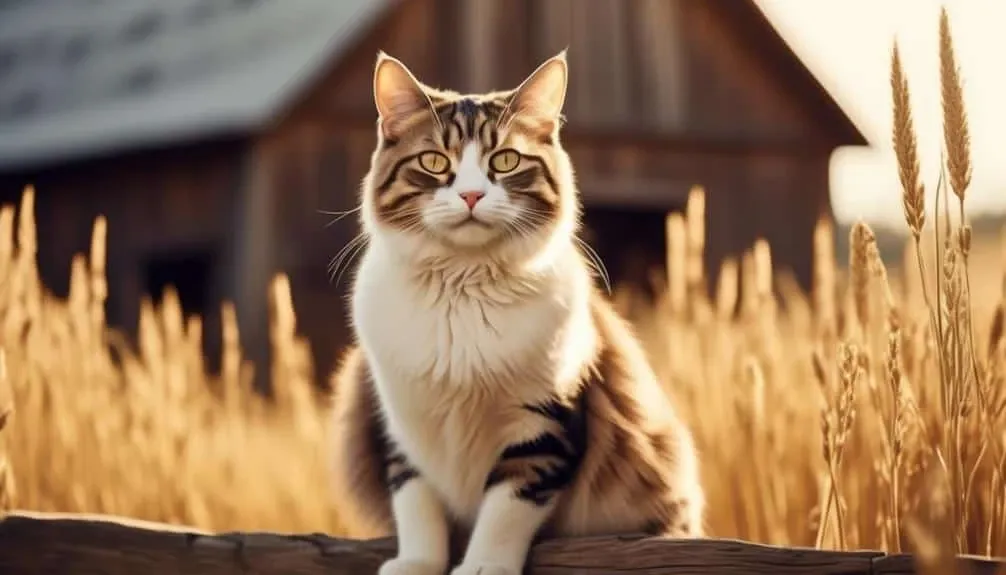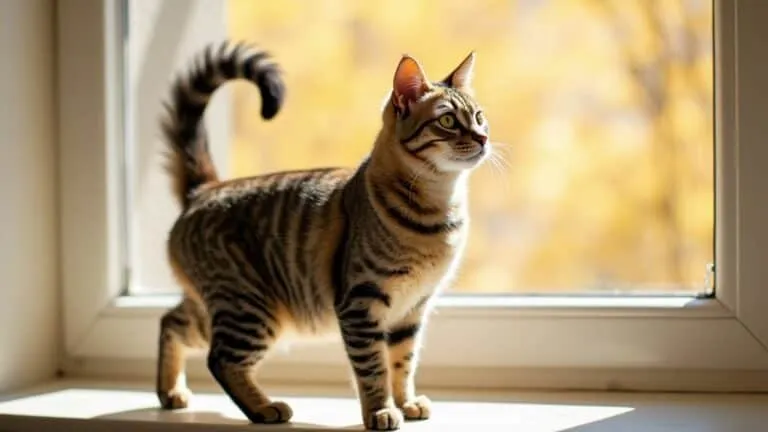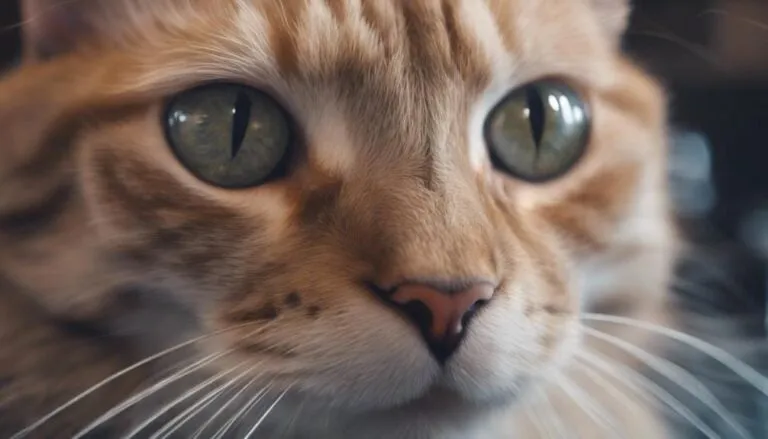The Best Fluffy Pancakes recipe you will fall in love with. Full of tips and tricks to help you make the best pancakes.

Are you ready to uncover the secrets of these enigmatic yet invaluable creatures that have silently aided farmers for centuries? Step into the world of barn cats, the ancient allies who have mastered the art of hunting and adapted to thrive in the agricultural landscape.
With their mysterious mixed breed heritage, independent nature, and unique physical traits, these feline companions have become an integral part of farm life. But what is it exactly that makes barn cats so special?
Join us on this journey as we unravel their fascinating history and explore their significant role in the intricate dance between humans and animals.
Get ready to discover the captivating world of barn cats, where their ancient bond with farmers holds untold stories waiting to be revealed.
Key Takeaways
- Barn cats are domestic cat breeds that have adapted to life in agricultural settings.
- They have a wide range of personalities, from friendly to completely wild, but are generally independent and self-sustaining solitary hunters.
- Barn cats have physical traits such as large size, dense coats, long tails, and wide paws, which make them more suited for outdoor life.
- They are often found in barns and other covered structures, where they provide a valuable service by hunting vermin.
What Are Barn Cats?
Barn cats are mixed breed domestic cats that have adapted to living in agricultural settings, displaying independence and self-sufficiency as self-sustaining solitary hunters. Their role in pest control is invaluable to farmers, as they actively hunt and control populations of rodents, birds, and other small pests that can cause damage to crops and stored grains.
By adopting a barn cat, farmers can benefit from a natural and environmentally friendly method of pest control, reducing the need for harmful chemical pesticides. Barn cats are hardy and resilient, able to withstand the elements and thrive in outdoor environments. They require minimal care and are low maintenance, making them perfect companions for busy farmers.
Furthermore, by providing a home for a barn cat, farmers are giving these animals a second chance at life, providing them with shelter, food, and a purpose.
Physical Traits of Barn Cats
Physical Traits of Barn Cats
As we shift our focus to the physical traits of barn cats, it's important to understand the characteristics that make these feline hunters well-suited for their agricultural environments. Here are some key physical traits of barn cats:
- Variety of Breeds: Barn cats are usually mixed breeds descended from various feral and stray cats.
- Large Size: Barn cats tend to be larger in size, which makes them more physically capable of life outside.
- Dense Coats: They've thick, dense fur coats that provide more protection against extreme cold.
- Sturdy Build: Barn cats typically have long tails and wide paws, giving them a sturdy and agile build for hunting.
When considering barn cat breeding, it's important to focus on maintaining these physical traits to ensure their adaptability and survival in agricultural settings.
Additionally, proper healthcare is crucial to address any barn cat health concerns that may arise. By understanding and appreciating their physical traits, we can better support these ancient allies of farmers in their important role as rodent hunters.
Personality and Behavior of Barn Cats
When considering the personality and behavior of barn cats, it's important to understand their independent nature and strong prey drive. Barn cats are playful hunters, known for their instinctual hunting behaviors.
While they may not be as interactive with humans as house cats, they still display their playful side through hunting-like behaviors. Barn cats have a natural inclination to chase and pounce on objects, mimicking their hunting instincts. This behavior allows them to stay sharp and active, even in their outdoor environment.
While they may not seek out constant interaction with humans, barn cats can still form bonds with their caretakers over time. By providing them with a safe and comfortable environment, ample food and water, and occasional socialization, barn cats can thrive and become valuable allies on the farm.
Preferred Living Environments for Barn Cats
Barn cats thrive in quiet, sheltered environments that provide warmth, protection, and an abundant supply of prey. Ideal habitats for barn cats include:
- Barns and sheds: These structures offer a cozy and safe space for barn cats to seek shelter from the elements. They also serve as valuable hunting grounds due to the presence of rodents.
- Fields and grain stores: Barn cats can often be found in agricultural areas where they can hunt for mice, rats, and other vermin that may inhabit these locations.
- Farmhouses with flexible arrangements: Some barn cats have the opportunity to become part-time house cats, allowing them to sleep inside when needed while still maintaining their independent lifestyle.
- Anywhere rodents may live or nest: Barn cats are skilled hunters, and they're attracted to areas where they can find ample prey.
To ensure proper barn cat care, it's important to create an environment that meets their needs for warmth, protection, and hunting opportunities.
Origins of Barn Cats
As we explore the origins of barn cats, it's fascinating to trace back their history and understand how they became the ancient allies of farmers. Barn cats have their roots in feral cat populations. These feral cats found a new home on farms or were strays that ran away or were abandoned. Over time, they formed self-sustaining populations of barn cats through reproduction.
The evolution of barn cats can be traced back to 7,500 BC when they were first domesticated, making them the earliest domesticated cats. Interestingly, many farm cats were once ship cats that served the same purpose on their way to suitable farms.
This mutually beneficial relationship between farmers and barn cats has been enduring for centuries.
Historical Significance of Barn Cats
Throughout history, barn cats have played a vital role in the lives of farmers, providing indispensable pest control and companionship on agricultural lands. These ancient allies have had a historical significance that can't be ignored. Here are some key points to consider:
- Role in pest control: Barn cats have been instrumental in keeping agricultural lands free from pests such as mice, rats, and other vermin. Their hunting instincts and agility make them excellent at catching and controlling these unwanted creatures.
- Relationship with farmers: Barn cats have developed a unique bond with farmers over the years. They not only provide practical benefits in the form of pest control but also offer companionship and a sense of familiarity on the farm. Farmers often rely on barn cats to help maintain a healthy and productive environment.
- Historical presence: Barn cats have been living alongside humans since the dawn of civilization. They were the first domesticated cats and have been an integral part of farming practices since 7,500 BC. Their presence on farms has been a constant throughout history.
- Cultural significance: Barn cats have become ingrained in the culture and folklore of farming communities. They're often seen as symbols of good luck and protection against evil spirits. Their presence is celebrated and cherished by farmers worldwide.
Barn cats have stood the test of time, proving their worth in pest control and forming deep connections with farmers. Their historical significance can't be overstated, as they continue to be essential allies in the agricultural landscape.
Frequently Asked Questions
How Do Barn Cats Contribute to Pest Control on Farms?
Barn cats contribute to pest control on farms by providing organic pest control, which benefits sustainable farming practices. They play a crucial role in keeping vermin populations in check, helping to protect crops and reduce the need for chemical pesticides.
Can Barn Cats Be Kept as Indoor Pets?
Yes, you can keep barn cats indoors as pets. There are benefits to having barn cats as indoor pets, including companionship and reducing the risk of them getting injured or encountering predators.
What Should Farmers Consider Before Adopting a Barn Cat?
Before adopting a barn cat, factors and considerations for farmers include the cat's ability to control pests, compatibility with existing animals, and providing proper shelter and healthcare.
How Can Farmers Ensure the Health and Well-Being of Their Barn Cats?
To ensure the health and well-being of your barn cats, provide regular vet care, proper shelter, access to food, and clean water. Taking these steps will help keep your feline allies happy and thriving on the farm.
Are There Any Specific Training or Socialization Needs for Barn Cats?
When it comes to barn cats, training and socialization needs can vary. Some barn cats may benefit from basic training to ensure safety and cooperation, while socialization can help them become more comfortable around humans.
Conclusion
In the captivating world of barn cats, these ancient allies have proven themselves to be more than just furry companions. With their adaptability, hunting prowess, and independent nature, barn cats have become an indispensable part of farm life.
As they continue to silently work alongside farmers, their significance in the symbiotic relationship between humans and animals can't be overstated.
So next time you find yourself in the presence of these unsung heroes, remember the deep bond they share with the farmers they call family.








